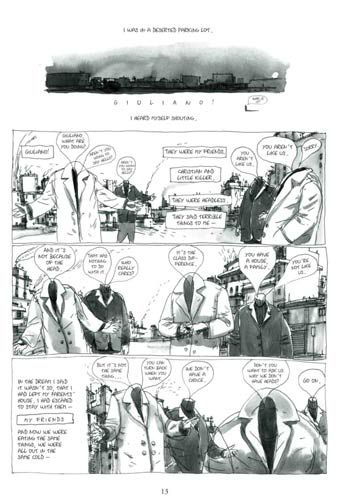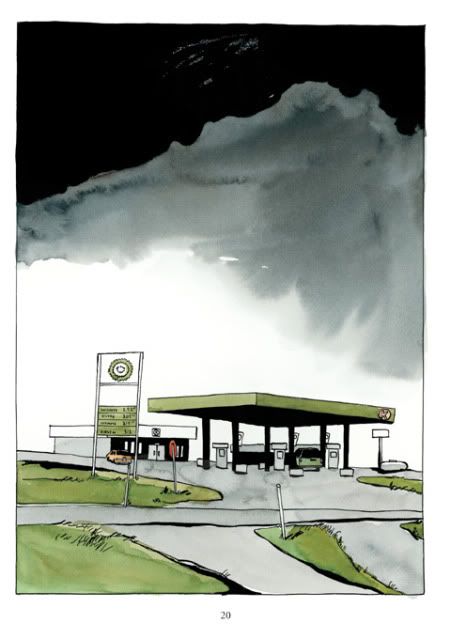Anyway, I’ve been dealing with the problem of the dirty wash. It does some things very well. It can evoke a rainy day, a cold winter, or a bleary mood. However, it’s really hard to get a dirty wash to be a hot, sweltering day.
Gipi is fantastic at the bleary day dirty wash.

His rain and cold is driving away and covering up all that you once knew. But summer really isn’t about the sad, mourning of what is lost and what you are losing. And I’m not sure Gipi ever even attempts the mood and setting of summer.
Novgorodoff attempted something like a hot summer day dirty wash.

She never really is able to reach that warmth. She is forced to use light yellow and blue watercolor to achieve the bright morning that shows early in her book, Slow Storm.
Eisner is the obvious first choice for warm summer days shown in a dirty wash. And he does it well.

However, I still don’t think that this is what I’m looking for. When Eisner shows a summer day, it is harsh in its contrast. When the contrast appears, it’s in a light brown and a dark sepia (most of his later work was published in sepia on a tan page), two fairly soft colors, that manage to create two totally different tones; which look oddly less than soft and cause the panels to end up harsh and with an almost masculine sort of distancing. Eisner’s dirty washes portraying hot summer seem to set the groundwork for Alex Kim, Jeff Smith, and Jason whose work always has a sort of air-conditioned feel to it. These artists work completely in a hard black and a blank white. And will only submit their work to a colorist if they feel the work needs it. These stark contrasts merely imply that the sun is shining brightly and that environment definition is clear.
Heat is a problem that seems to be only solved by the characters and by absurd cartooning (cold has the same problem but snow solves it for the most part). It can be drawn into the environment, like heat coming off the blacktop shown by heat “waves”, or the can be emoted by the character, like dripping sweat. Neither of these things is inherent in the environment. If you were a realist, you would not draw wavy lines coming up from pavement or flecks of sweat as big as an eyeball falling off a person. Heat has to be shown as an exaggeration of real life.
Dirty washes, while properly conveying a drab and dreary day and impending doom, do not do a good job of conveying a hot day. Maybe some one will come along and figure a way to correctly use a dirty wash for a summer day, but I haven't seen it. Until then, I figure we must be patient until the cartooning world solves this problem (if you would even call it that as it's more of a personal desire to fit something into a place where it doesn't belong).
How does this apply to you and how you put clothes on in the morning? If you have to think about how to pull something off, maybe you should give your self more time to sort it out. Contrivance is born out of impatience. Take the time to work things out. Lay everything out in your mind, select examples, and think long and hard before you decide something is actually better.

No comments:
Post a Comment